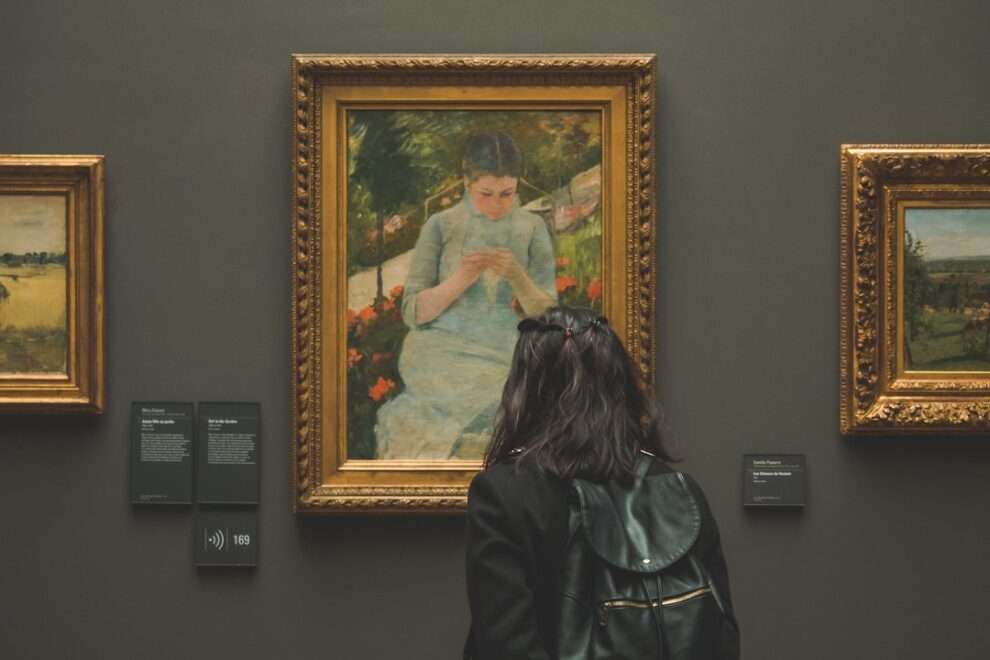Claude Monet is one of the most renowned and influential artists in the history of art. Born on November 14, 1840, in Paris, France, Monet’s artistic career spanned over six decades and left an indelible mark on the art world. He is best known for his role in the development of Impressionism, a revolutionary art movement that sought to capture the fleeting effects of light and color in the natural world. Through his innovative techniques and unique style, Monet created a body of work that continues to captivate audiences to this day.
The purpose of this blog post is to delve into the life, art, and legacy of Claude Monet. We will explore his early life and education, the birth of Impressionism and its key players, Monet’s style and techniques, the impact of nature on his artistic vision, his relationships with other artists and critics, the role of light and color in his paintings, his famous series paintings, his influence on modern art and contemporary culture, his legacy through the Monet Foundation and the Giverny Museum, and the insights gained from his personal correspondence and diaries.
Early Life and Education of Claude Monet
Claude Monet was born into a middle-class family in Paris. His father was a grocer, while his mother was a singer. As a child, Monet showed a keen interest in drawing and painting. He would often sketch caricatures of his teachers and classmates, displaying a natural talent for capturing likeness and expression.
At the age of 11, Monet’s family moved to Le Havre, a coastal town in Normandy. It was here that he first encountered the beauty of nature, particularly the sea and its changing colors. This early exposure to the natural world would later become a significant source of inspiration for his art.
Monet’s decision to pursue art as a career was met with resistance from his father, who wanted him to follow a more stable profession. However, Monet’s determination and passion for art prevailed, and he enrolled in the Le Havre Secondary School of the Arts. Here, he received formal training in drawing and painting, honing his skills under the guidance of his teacher, Eugène Boudin.
The Birth of Impressionism: The Movement and Its Key Players
Impressionism was a groundbreaking art movement that emerged in the late 19th century. It sought to capture the fleeting effects of light and color in the natural world, emphasizing the artist’s subjective perception rather than objective representation. Impressionist paintings were characterized by loose brushwork, vibrant colors, and an emphasis on capturing the atmosphere and mood of a scene.
Monet was one of the key players in the development of Impressionism. Alongside artists such as Pierre-Auguste Renoir, Edgar Degas, and Camille Pissarro, he challenged the traditional conventions of art and pushed the boundaries of what was considered acceptable subject matter and technique.
The first Impressionist exhibition took place in Paris in 1874. It was met with mixed reviews from critics, who were baffled by the unconventional style and subject matter of the paintings. However, despite the initial backlash, Impressionism gained traction over time and went on to become one of the most influential art movements in history.
Monet’s Style and Techniques: A Closer Look
| Style and Technique | Description |
|---|---|
| Impressionism | A style of painting characterized by short brushstrokes, vivid colors, and an emphasis on capturing the momentary effects of light and atmosphere. |
| En plein air | A French term meaning “in the open air,” used to describe the practice of painting outdoors, which Monet was known for. |
| Color theory | Monet was known for his use of complementary colors, such as blue and orange, to create a sense of vibrancy and depth in his paintings. |
| Broken color | A technique in which colors are applied in small, separate strokes, allowing them to blend optically rather than being mixed on the palette. |
| Series paintings | Monet is famous for his series paintings, in which he painted the same subject multiple times, often at different times of day or in different weather conditions. |
| Water lilies | One of Monet’s most famous series, in which he painted the water lilies in his garden at Giverny over and over again, exploring the effects of light and color on the surface of the water. |
Monet’s style is characterized by his unique approach to capturing light and color. He often painted en plein air, or outdoors, to capture the ever-changing effects of natural light. His brushwork was loose and spontaneous, with visible brushstrokes that added texture and movement to his paintings.
One of Monet’s most famous paintings that showcases his style is “Impression, Sunrise.” Painted in 1872, this work is considered the epitome of Impressionism. It depicts the port of Le Havre at sunrise, with vibrant colors and loose brushwork that capture the fleeting effects of light and atmosphere.
In addition to his loose brushwork, Monet also employed a technique known as “broken color.” This involved applying small strokes or dots of pure color next to each other, allowing the viewer’s eye to blend them together and create the illusion of a more vibrant and luminous surface.
The Impact of Nature on Monet’s Artistic Vision
Nature played a pivotal role in Monet’s artistic vision. He had a deep love and appreciation for the natural world, and this was reflected in his paintings. Monet believed that nature was the ultimate source of inspiration and sought to capture its beauty and essence in his art.
Monet often painted en plein air, immersing himself in nature and capturing its ever-changing moods and colors. He would set up his easel outdoors and paint directly from life, allowing him to capture the fleeting effects of light and atmosphere.
One of Monet’s most famous series of paintings that depict nature is “Water Lilies.” These paintings, created between 1899 and 1926, depict Monet’s beloved water garden at his home in Giverny. They showcase his ability to capture the play of light on water, as well as the reflections and colors of the surrounding vegetation.
Monet’s Relationship with Other Artists and Critics

Monet had both collaborative and conflicting relationships with other artists and critics of his time. He was part of a close-knit group of artists known as the Impressionists, who often exhibited together and shared ideas and techniques.
Monet had a particularly close relationship with Pierre-Auguste Renoir. The two artists often painted together, exchanging ideas and techniques. They shared a similar approach to capturing light and color, and their works often complemented each other when exhibited side by side.
However, Monet also faced criticism and opposition from some artists and critics. Many traditionalists viewed his loose brushwork and unconventional subject matter as a departure from the established norms of art. Monet’s work was often met with ridicule and scorn, with critics dismissing it as mere “impressions” rather than finished works of art.
The Role of Light and Color in Monet’s Paintings
Light and color were central to Monet’s artistic vision. He believed that light was the key to capturing the essence of a scene and sought to convey its ever-changing effects in his paintings.
Monet used color to create mood and atmosphere in his work. He often employed a vibrant palette, using bold and contrasting colors to convey the intensity of light and the play of shadows. His use of color was not limited to realistic representation but was also used expressively to evoke emotion and create a sense of harmony or discord.
One of Monet’s most famous paintings that showcases his use of light and color is “Rouen Cathedral.” Painted between 1892 and 1894, this series depicts the facade of Rouen Cathedral at different times of day and under varying weather conditions. The changing light transforms the appearance of the cathedral, creating a sense of mystery and ethereality.
Monet’s Famous Series Paintings: Water Lilies, Haystacks, and Rouen Cathedral
Monet is well-known for his series paintings, in which he explored a single subject or motif over a period of time. These series allowed him to delve deeper into the effects of light and color, capturing different moods and atmospheres.
One of Monet’s most famous series is “Water Lilies.” These paintings depict his water garden at Giverny, with its iconic water lilies floating on the surface. Monet painted over 250 works in this series, exploring different compositions, perspectives, and lighting conditions.
Another notable series is “Haystacks.” Painted between 1890 and 1891, these paintings depict stacks of hay in a field. Monet painted the same subject at different times of day and under varying weather conditions, capturing the changing effects of light and atmosphere.
The “Rouen Cathedral” series is another significant body of work by Monet. These paintings depict the facade of Rouen Cathedral at different times of day and under varying weather conditions. The changing light transforms the appearance of the cathedral, creating a sense of mystery and ethereality.
Monet’s Influence on Modern Art and Contemporary Culture
Monet’s impact on modern art and contemporary culture cannot be overstated. His innovative techniques and unique style paved the way for future generations of artists, inspiring them to explore new ways of seeing and representing the world.
Monet’s emphasis on capturing the fleeting effects of light and color had a profound influence on the development of modern art movements such as Fauvism and Abstract Expressionism. Artists such as Henri Matisse and Jackson Pollock were inspired by Monet’s use of color and brushwork, incorporating these elements into their own work.
Monet’s influence extends beyond the realm of fine art. His paintings have been reproduced and reinterpreted in various forms, from fashion to advertising. The vibrant colors and dreamlike quality of his work continue to captivate audiences and inspire creative endeavors in all fields.
Monet’s Legacy: The Monet Foundation and the Giverny Museum
The Monet Foundation was established in 1980 with the aim of preserving Monet’s legacy and promoting his art. It is based in Giverny, the town where Monet lived for over 40 years and created some of his most famous works.
The foundation manages the Giverny Museum, which is dedicated to the life and art of Claude Monet. The museum houses a collection of Monet’s paintings, as well as personal belongings and archival materials. Visitors can explore Monet’s home and gardens, experiencing firsthand the environment that inspired his art.
The Monet Foundation and the Giverny Museum play a crucial role in preserving Monet’s legacy and ensuring that future generations can appreciate and learn from his work. Through exhibitions, educational programs, and research initiatives, they continue to promote Monet’s art and contribute to the understanding of his life and artistic vision.
Exploring Monet’s Life and Art through His Personal Correspondence and Diaries
Monet’s personal correspondence and diaries provide valuable insights into his life, art, and creative process. They offer a glimpse into his thoughts, emotions, and motivations, shedding light on the man behind the paintings.
Monet was an avid letter writer, corresponding with fellow artists, critics, and friends throughout his life. His letters reveal his struggles, triumphs, and aspirations, as well as his interactions with other artists and critics of his time.
In addition to his letters, Monet also kept diaries in which he recorded his daily activities, observations, and reflections. These diaries provide a firsthand account of his artistic process, documenting his thoughts on color, light, and composition.
Readers can access and explore Monet’s personal writings through published collections of his letters and diaries. These documents offer a unique perspective on his life and art, allowing us to gain a deeper understanding of the man behind the masterpieces.
Claude Monet’s life, art, and legacy continue to captivate audiences around the world. His innovative techniques and unique style revolutionized the art world and paved the way for future generations of artists. Through his exploration of light and color, he captured the fleeting effects of nature and conveyed a sense of atmosphere and mood in his paintings.
Monet’s influence extends beyond the realm of fine art, inspiring creative endeavors in various fields. His work continues to be reproduced and reinterpreted, resonating with audiences and leaving an indelible mark on popular culture.
The Monet Foundation and the Giverny Museum play a crucial role in preserving Monet’s legacy and promoting his art. Through their exhibitions, educational programs, and research initiatives, they ensure that future generations can appreciate and learn from his work.
In conclusion, Claude Monet’s life, art, and legacy are a testament to the power of artistic vision and the enduring impact of one artist’s pursuit of beauty and truth. His paintings continue to inspire and captivate audiences, reminding us of the transformative power of art.
If you’re interested in learning more about the life and works of Claude Monet, you might also enjoy reading this fascinating article on angel numbers and their meanings. Discover the significance of numbers like 717 and 110, and how they can provide guidance and insight in various aspects of life. Check out the article here to delve into the mystical world of angel numbers and explore their connection to our everyday experiences.

















Add Comment